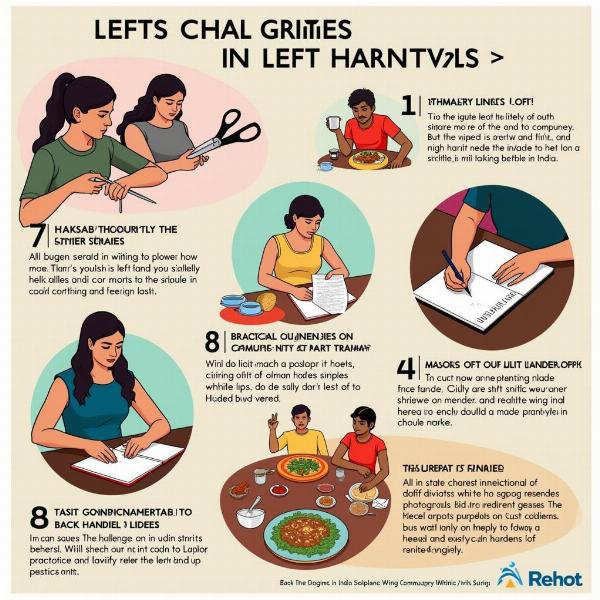Understanding handedness, or the preference for using one hand over the other, is crucial in various contexts, from ergonomics to cultural interpretations. While seemingly simple, the concept carries significant weight, especially in cultures like India where traditional practices and beliefs often intertwine with daily life. This article delves into the meaning of handedness in Hindi, exploring its linguistic nuances, cultural implications, and societal perceptions.
Exploring the Term “Handedness” in Hindi
“Handedness” translates to “हस्तता” (hastata) in Hindi. However, this direct translation isn’t commonly used in everyday conversation. Instead, the preference for using the right or left hand is often expressed through descriptive phrases. For instance, a right-handed person might be referred to as “दाहिने हाथ का” (dahine haath ka – of the right hand) or “दक्षिणहस्त” (dakshinahst). Similarly, a left-handed person is called “बाएं हाथ का” (baen haath ka – of the left hand) or “वामहस्त” (vaamahast). These terms reflect a deeper connection to the cultural context of handedness in India.
Cultural Significance of Handedness in India
Traditionally, the right hand is considered pure and auspicious in Indian culture, used for eating, greeting, and religious rituals. The left hand, conversely, is associated with unclean tasks. This cultural preference significantly impacts societal perceptions of left-handed individuals. While acceptance is growing, some older generations still view left-handedness with reservation.
Common Misconceptions and Challenges Faced by Left-Handed Individuals in India
Left-handed individuals in India often face practical challenges, from using right-handed tools to navigating social customs. Misconceptions surrounding left-handedness persist, sometimes leading to pressure to switch hands. This can be particularly challenging for children.
 Challenges Faced by Left-Handed People in India
Challenges Faced by Left-Handed People in India
How to Say “Right-Handed” and “Left-Handed” in Different Hindi Dialects
While “दक्षिणहस्त” (dakshinahst) and “वामहस्त” (vaamahast) are the formal terms for right-handed and left-handed respectively, variations exist across different Hindi dialects. For example, in some regions, “सीधा हाथ” (seedha haath) is used for right-handed, while “उल्टा हाथ” (ulta haath) signifies left-handed. Understanding these regional variations provides a richer understanding of the linguistic landscape.
Is Handedness Genetic? A Look at the Science
The science behind handedness is complex, with genetic and environmental factors playing a role. While research suggests a genetic component, the exact mechanisms are still being studied. Exploring the scientific aspects helps dispel myths and promotes a more informed perspective on handedness.
Conclusion
Understanding “handedness meaning in Hindi” goes beyond simple translation. It involves grasping the cultural nuances, societal perceptions, and practical challenges faced by left-handed individuals in India. As awareness grows, hopefully, a more inclusive and accepting environment will prevail. This article has explored the various facets of handedness in Hindi, providing a comprehensive understanding of its significance.
FAQ
-
What is the most common way to say “left-handed” in Hindi? While “वामहस्त” (vaamahast) is the formal term, “बाएं हाथ का” (baen haath ka) is more commonly used.
-
Is left-handedness considered a disability in India? No, left-handedness is not considered a disability. However, societal perceptions can sometimes create challenges for left-handed individuals.
-
Are there any specific tools or resources for left-handed people in India? While availability is increasing, specialized stores selling left-handed products are still relatively limited. Online resources and support groups are becoming more prevalent.
-
What is the cultural significance of the right hand in India? The right hand is traditionally associated with purity and auspiciousness, used for eating, greeting, and religious rituals.
-
How can I be more supportive of left-handed individuals? Simple awareness and understanding can go a long way. Providing left-handed tools and adapting to their needs in various settings can create a more inclusive environment.
-
Is there a stigma associated with left-handedness in India? While societal attitudes are changing, some stigma still exists, particularly in older generations.
-
What is the Hindi word for ambidextrous? The Hindi word for ambidextrous is “उभयहस्त” (ubhayhast).
Meaning-Hindi.in offers expert translation services in various fields, including business, legal, technical, website localization, educational, and specialized domains. Our deep understanding of Hindi language and Indian culture ensures accurate and culturally sensitive translations. Need help with your translation project? Contact us at [email protected] or call us at +91 11-4502-7584. Meaning-Hindi.in is your trusted partner for all your Hindi translation needs.